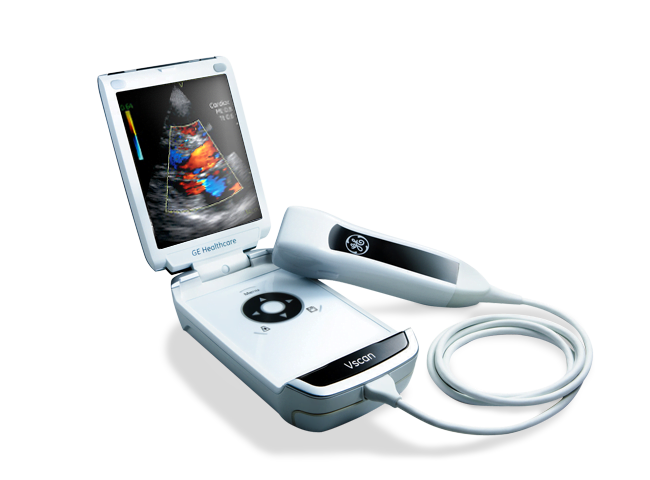As it seems to be ultrasound month on BoringEM (see the guest posts from Paul Olszynski here: A Pictorial Approach to Ultrasound in Shock and Chris Byrne here: Point of Care Ultrasound: A Hyperechoic Future in Med Ed), I thought I’d chime in with a review of my new toy. I just completed a four week rotation at a regional ED that is not equipped with an ultrasound unit. Fortunately, my residency program purchased a GE VScan handheld ultrasound machine for the use of our residents. I’ll admit that I felt a bit spoiled walking into this ED toting a portable U/S in my pocket when they had been asking for one for years, but it was nice to have!
For the unacquainted, the VScan is a “pocket-sized ultrasound” made by GE that retails for approximately $7,900. Details for the hardcore interested are available here. It comes with a 4GB micro-SD card (you can substitute a larger card if you need) for image capture and one phased-array probe. It has preprogrammed presets for cardiac, abdominal and obstetrical scans and is advertised as also also being suitable for urology, peripheral vascular and pleural fluid/motion detection.
Before I start – a disclaimer. I would describe myself as a low level EM ultrasound user. I am an independent practitioner (IP) as certified by the Emergency Department Ultrasound Society in Canada and have instructed with the EDE1 course that covers the four primary indications (aortic aneurysm, subxiphoid view pericardial/cardiac standstill, intrauterine pregnancy, FAST) twice. While I have taken the EDE2 course (advanced applications such as parasternal/apical cardiac, DVT, pneumothorax, gallbladder, etc), I have only had a sufficient number of proctored/confirmed scans to feel comfortable in my use of ultrasound for pneumothorax and arterial & central line placement. For this reason, I will only review the VScan‘s usefulness for these scans and in the context of my residency program. I imagine that you’ll find this review much more useful if you are a trainee like me or someone similarly middling in your skillz. I imagine that more expert users, and especially those with substantial experience with the VScan, would be able to obtain better imagines and might review the product more highly.
As I’m discussing a product I feel like I should also reiterate the conflict-of-interest statement in the disclaimer section of BoringEM. To summarize, I have no money to invest in anything and nobody values my opinion enough for someone to want to pay me for it 😉 so I have absolutely no conflict-of-interest that relates to this product.
Onto the review!
VScan Portability – 3.5/5
Portable or not, in practice I didn’t carry the VScan around with me. Despite being advertised as “pocked-sized”, I found it too big and heavy to carry comfortably in my scrub pocket (although it did technically fit) and I would have been concerned that I would drop/break the probe during regular ED shift activity. It generally sat in its case at my desk until it was needed. Suffice to say, I think ultrasound technology still has a way to go before I will carry one around my neck like this:
I look forward to the day when I can get wireless ultrasound probe(s) that transmit images to my smartphone over bluetooth and come with a sturdy clip to attach to my scrubs! With that being my 5/5 ideal, I give it a 3.5/5 because it is still substantially more portable than the M-Turbo that I’m used to. Interestingly, occasional BoringEM author Paul Olszynski (who also peer-reviewed this post and is currently enhancing his ultrasound skills in England) has also trialed the VScan and felt it was very easy to walk around with. To each their own!
VScan Battery – 4.5/5
I found the battery life was more than adequate to last a few shifts at a time. I docked 0.5 star because the charging station was pretty bulky for sitting around my house where it slept. It would be a great station for an ED-based VScan.
VScan Quality
I’ll rate the VScan on its usefulness this scan-by-scan after a single month of use. In general, I found that while it is very small, I found the single phased-array probe to be limiting. Combining this with a smaller screen size and less resolution than what I am used to getting from my buddy the M-Turbo, I found it more difficult overall to produce adequate images. However, I did get better as I better with ongoing use over the month. The 5/5 comparable for these rankings are the subjective images that I am able to produce with an M-Turbo.
Aortic Aneurysm – 3.5/5
I found it substantially more difficult to get a conclusive aorta scan with the VScan. I imagine this was due to a combination the smaller screen, the decreased frequency, and the smaller size of the phased array probe. I found bowel gas to be more problematic than useful because the smaller probe head reduced the amount of pressure that I could compress with while keeping the patient relatively comfortable. My peer-reviewer Paul Olszynski pointed out that this may have been ameliorated by simply using something blunter (like my hand!) to provide pressure. Like usual, he’s right, so I added a 0.5 star onto my original score of 3.
Subxiphoid Cardiac – 4.5/5
Phased-array probes were basically made for cardiac scans and you can tell. I got great subxiphoid images and even some good (for me) parasternal and apical views. I still felt the small screen limited my image quality, but imagine that would continue to improve with practice and my ultrasound skills. The cardiac preset was a great starting point to get a solid image on most patients.
Intrauterine Pregnancy & Abdominal Free Fluid – 4/5
I found both of these scans to be pretty decent with the VScan. I’m sure a larger screen would have helped to better visualize earlier gestation pregnancies and small slips of free fluid, but I was able to consistently get relatively good quality images. The presets for these scans were great starting points for most patients as well.
Pneumothorax – 2.5/5
I generally do this scan with a high frequency linear array probe with multi-beam off, so the picture I saw with the VScan was quite different and that made me less confident in my interpretation. The probe fits nicely between ribs, but there was no pulmonary preset and despite messing with the gain and depth with ferocity, I still found that the images I produced were inferior.
Vascular – ?/5
Honestly, I never even tried to use the VScan for vascular applications. I was taught to do vascular scans using a high frequency linear array probe and didn’t even think to attempt looking at the vasculature with the phased array probe until reading the product description on the GE site.
Unanticipated Benefits
Besides the obvious benefit of being able to work on my ultrasound skills while on a rotation during which I would have otherwise not scanned anyone for a month, there were two unanticipated benefits to using the VScan:
1 – It allowed me to be an ambassador for POCUS (point-of-care ultrasound)
I think bringing a handheld ultrasound with me on my rotation was a good exposure for a department that had yet to develop their own EM ultrasound program. The nurses asked what it was and saw the utility of showing worried pregnant women visual confirmation of their baby’s beating heart (see this small study by my PD that showed a reduction in miscarriage rate from ~80% for a scan that was nondiagnostic of intrauterine pregnancy to ~15% for a scan showing a live IUP). The doctors were keen to discuss ultrasound applications and talk about their efforts to acquire a machine in the very near future. I anticipate that when our residents carry the VScan around with them on off-service rotations in our center there may be similar interest from general surgery, obstetrics, internal medicine and anesthesia residents and staff. I can only see the further exposure to POCUS that results from a walking ultrasound machine helping to facilitate its wider adoption.
2 – I looked really cool walking around with it
Or at least I thought so… I didn’t take a picture, but in my head I imagined that I was giving off a cutting edge impression. In retrospect, I may have actually looked like this guy:
Conclusion
I think the VScan is a solid portable ultrasound device that, in skilled hands, can provide adequate images for a number of important scans. I think it is a great purchase for our residency program where it will be lent out to residents on off-service and off-site rotations to help them maintain their basic skills while demonstrating the benefits of POCUS around our health region. However, in my home ED I would stick to my trusty M-Turbo any day of the week. I look forward to the day when I find an ultrasound machine portable and convenient enough to carry around and use like a stethoscope, but unfortunately the VScan is not that device for me.
Have you used the VScan or a similar handheld device? What did you think? Get back to me in the comments or on twitter.
Peer reviewed by Paul Olszynski






